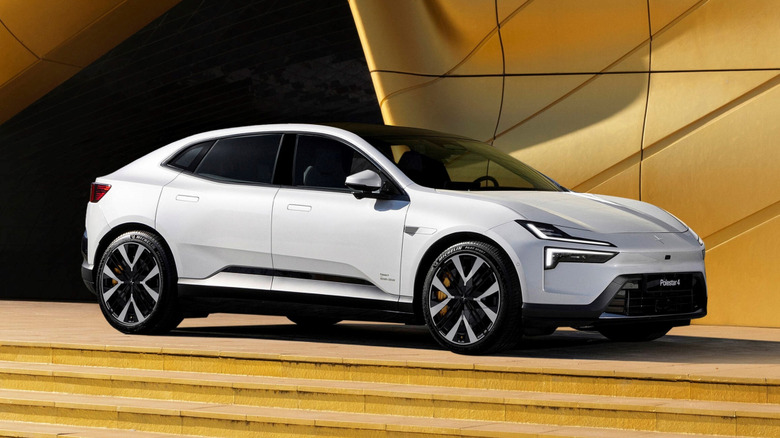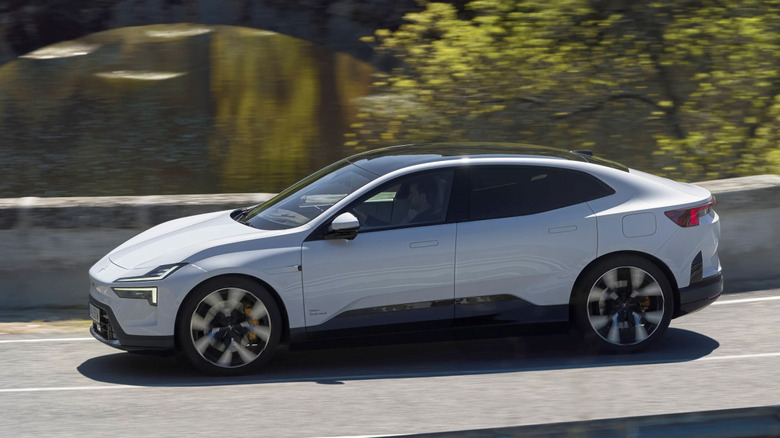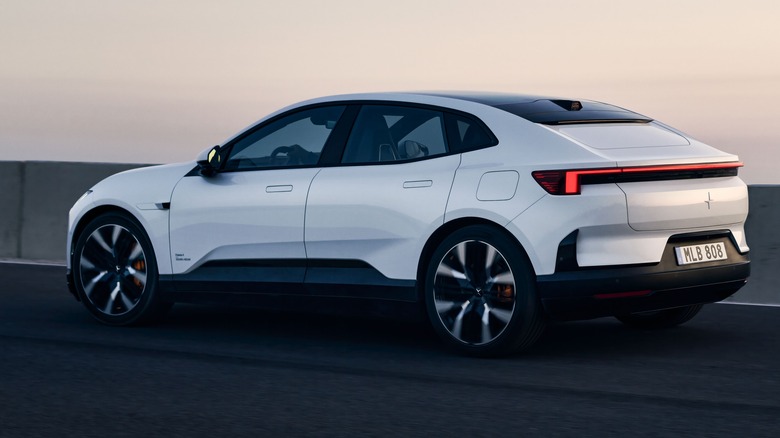2026 Polestar 4: How Its Price, Speed, & Range Compares To The Tesla Model Y
Polestar has announced that its coupe-ish SUV is officially on sale in the U.S. market. You will, however, have to wait to get behind the wheels of this sleek electric ride as deliveries are only expected to commence in the fall. The Polestar 4 is the brand's fastest production car so far, and it will be available in single (RWD) and dual-motor (AWD) configurations, spaced across five models in total.
The asking price of $56,400 (excluding a destination fee of $1,400) is the real attraction, undercutting the likes of Porsche Macan EV, Genesis GV70, Audi SQ6 e-tron, and the Jaguar i-Pace, while rubbing shoulders against the likes of Volvo EX40 and the Cadillac Optiq. The real litmus test will be against the Tesla Model Y (in its refreshed Juniper avatar), which comes in at a more attractive price point and an established EV tech stack that's generally deemed the best out there.
Before we get into the direct comparisons, do keep in mind that Polestar offers a bunch of conveniences with specific customization bundles. The standard Pilot pack offers adaptive cruise control, alloy wheels, a glass roof, and car key support for Apple devices. The Plus pack adds electronically adjustable front and rear seats, a graphical head-up display, triple zone climate control, and heated wheel and seats. The Performance pack delivers 22-inch wheels, Brembo calipers, chassis tuning, and golden design accents.
What's the hit on your wallet?
Now, let's dig into the Polestar 4 comparison against the Tesla Model Y. The entry-point single-motor model starts at $56,400 with the Pilot pack configuration. The dual-motor configuration starts at $62,900, going all the way up to $72,900 for the trim with the Performance pack tuning.
Coming to the Tesla Model Y, you'll have to spend $44,990 for the Long Range (RWD) trim, and part ways with $48,990 for the all-wheel drive variant. The tow-hitch will set you back by another $1,000, while the full self-driving software package is a standalone purchase at $8,000. Tesla also charges a destination fee worth $1,390, and an additional $250 in order fee.
For folks interested in the lease model, you can get the Model Y in the U.S. starting at $459 per month. For the Polestar 4, the Geely and Volvo-backed Swedish label hasn't yet announced lease terms for its latest car. However, we expect it to be an option on the shopping table when the car finally starts shipping in the U.S. At the moment, the company is offering lease plans starting at $599 for the Polestar 3 in the U.S., alongside the claim of savings worth $20,000 for existing Tesla owners (or other EV brands) when they switch allegiance. Given the similarity in price brackets, we expect the Polestar 4 lease plans to fall in the same ballpark.
What about the performance chops?
The entry-point Tesla Model Y offers a peak range of 357 miles, while the higher-end all-wheel drive version trims those numbers down to 327 miles. On the former, the zero-to-60 mph mark can be achieved in 5.4 seconds, while the speedier AWD model can touch it in 4.6 seconds. The top speed across both models remains identical at 125 mph. Coming to the Polestar 4, the single motor (RWD) trim can accelerate from still to 60 mph in 6.9 seconds, while the dual motor (AWD) version can achieve it in 3.7 seconds, beating the Tesla Model Y. The top speed estimates given by Polestar stand at 124.24 mph, which roughly matches its Tesla rival.
The company is eyeing an EPA range of 300 miles for the single-motor variant of Polestar 4, while the per-charge mileage will be slightly lower on the dual-motor model at 270 miles. If you're interested in the WLTP range estimates, we're looking at 385 miles and 366 miles between the two versions. Irrespective of the bracket you go with, the Tesla Model Y comes out on top with better range figures.
Notably, the battery capacity and peak charging output remain constant across the Polestar 4 portfolio at 100 kWh and 200 kW, respectively. Charging speed is another area where the Tesla Model Y reigns supreme, thanks to support for 250 kW charging at V4 Supercharger hubs.


